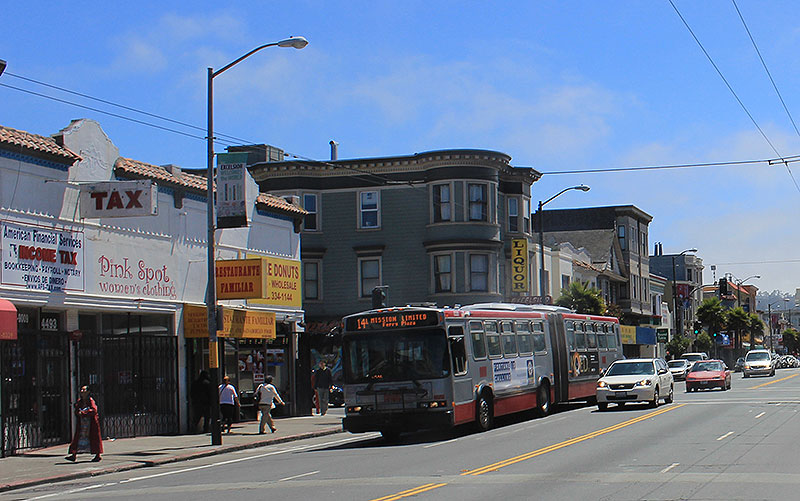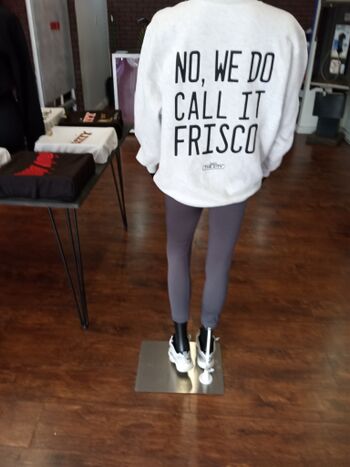Riding the 14R From One End to the Other
I was there . . .
by Howard Isaac Williams, 2023
Somewhere in the last decade the MUNI 14L [Limited] (seen here) was rechristened the 14R [Rapid]. The latter description is certainly more aspirational!
Photo: Chris Carlsson
Few experiences demonstrate so vividly the decline of San Francisco and the City’s attendant disregard for its working class as a ride on the Muni 14R bus. And yet signs of hope, resilience and resistance also appear along the ride from the 14R’s southern origin at the Daly City BART station to its finish seven miles away at Mission and Steuart Streets downtown.
Like every 14R (for “rapid”), the bus is an articulated one, a 60-foot-long vehicle with an accordion like pivot midway on its length to bend when making turns.
On Friday morning, March 3, 2023, just before 9 A.M., I put my bicycle on the front rack of a 14R at the Daly City BART to ride all the way downtown. As I board, I ask the driver, a middle-aged Latino man, how long he expects the ride to be. He says about 55 minutes. I ride the 14R almost every weekday for most of its route but this day I planned to take the entire seven-mile ride. With the exception of one block downtown, the “R” travels the entire length of Mission Street, San Francisco’s longest and most historic street. The 14R is distinguished from the 14 by its limited number of stops, making for a faster ride. While the 14 stops at well over half of Mission Street’s 60 intersections, the “R” makes only 21 stops.
From Daly City BART where I board with a few middle-aged men and women, the R goes east on John Daly Boulevard uphill to Mission Street at the “top of the hill” where it makes its next stop. Here more adults get on along with a few children. Now, nearly every seat is taken. Almost all people on board are either Latino, Filipino or Asian American. By outward appearances and the time of day, most seem to be going to work. Outside, the restaurants and small shops represent the demographics of the passengers. A Chinese restaurant stands diagonally across the street from a Filipino one. Stands of fresh fruits and vegetables brighten the outside of bodegas selling foods from Mexico and Central America. These restaurants, along with barber shops and nail salons, laundromats and auto repair shops, medical and other professional offices, make this part of Daly City look much like the southern stretch of Mission Street in San Francisco. But we are not yet in the City. Going downhill, the R passes a Walgreen’s store flanking the corner of Goethe Street; in the many times I’ve been here, I have never seen the organized shoplifting that Walgreen’s blamed for the closing of 15 of its San Francisco stores.
After passing Walgreen’s, houses appear, and the area becomes a mix of residential and commercial buildings. Then I see the first indication that we are in San Francisco. On the left (west), is a store window bearing a photo inscribed with the words “No we do call it Frisco.” While many San Franciscans adamantly say “Don’t call our City ‘Frisco’!”, others, including those born and raised in the City, especially in working class southern neighborhoods do say “Frisco.” The shop is called Made in the City and features shirts, caps and other apparel, all locally produced.


